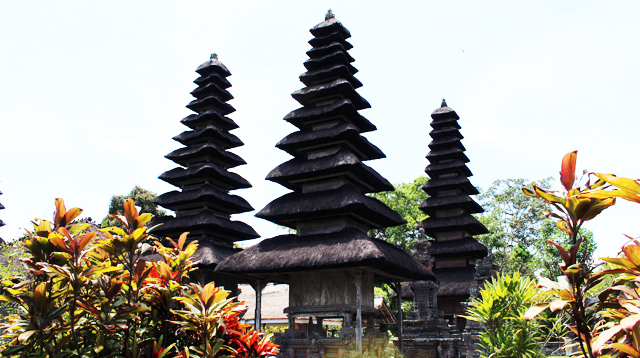TAMAN Ayun Temple, located in Mengwi, Badung, is one of the most revered and beautiful temples in Bali. Built in the 17th century by the King of Mengwi, it stands as a testament to Balinese architectural grandeur and spiritual depth.
Beyond its physical beauty, the temple carries profound philosophical and symbolic meaning within Balinese Hinduism, representing harmony, balance, and connection to the divine.
Symbolism
Designed with the philosophy of Tri Hita Karana—the harmony between God, humanity, and nature—Taman Ayun is a living symbol of balance. As you stroll through its lush gardens and cross the sacred moat, you are not just exploring a temple; you are experiencing the essence of peace and spiritual unity.
Let the timeless beauty of Taman Ayun Temple guide you on a journey of inner harmony, where nature, culture, and spirituality blend into one unforgettable experience.
Harmony with Nature: The name “Taman Ayun” translates to ‘beautiful garden,’ and its layout reflects an intimate relationship with nature. The temple is surrounded by a large, tranquil moat that symbolizes the cosmic ocean, a key concept in Hindu cosmology. This water feature not only enhances the serene atmosphere but also signifies the purification process before one enters the sacred grounds, where the mundane meets the spiritual.
The lush gardens within the temple complex represent the earthly realm, a place where humans live in harmony with their environment. The careful balance of natural beauty and architectural precision symbolizes how human life should be in sync with the natural world.
Tri Mandala Concept: Taman Ayun Temple is designed according to the ‘Tri Mandala’ concept, a core principle in Balinese architecture. This concept divides space into three areas, each representing different levels of spiritual purity:
- The outermost section, called Nista Mandala, represents the earthly or profane realm. It is where visitors first arrive and cleanse themselves before entering the sacred areas.
- The middle section, known as Madya Mandala, is the transitional space, symbolizing the human realm, where daily rituals and offerings are performed.
- The innermost sanctum, Utama Mandala, is the most sacred and represents the divine realm. Here, the most important spiritual ceremonies take place, and only the highest-ranking priests and worshippers are allowed entry.
This spatial division mirrors the Balinese Hindu belief in the interconnectedness of the human, natural, and spiritual realms. It reflects the Hindu concept of *Tri Hita Karana*, which promotes balance and harmony between God, humanity, and nature.
Meru Towers: Connection to the Divine—-The iconic multi-tiered ‘Meru’ towers within the temple complex are a significant feature of Taman Ayun. These pagoda-like structures are dedicated to various gods and ancestral spirits, and their tiered design symbolizes Mount Meru, the sacred mountain in Hindu mythology that represents the center of the universe.
The higher the number of tiers, the greater the divinity or importance of the deity being honored. The tallest ‘Meru’ at Taman Ayun has eleven tiers, symbolizing the highest connection to the supreme deity, Ida Sang Hyang Widhi Wasa. These towers are a reminder of humanity’s reverence for the divine and the importance of maintaining a spiritual connection with the higher realms.
Community and Cosmology: Taman Ayun Temple also holds significant meaning for the local community, particularly the royal family of Mengwi, who built the temple as a symbol of their devotion to the gods and their ancestors. It serves as a ‘Pura Kawitan’ (family temple) for the royal lineage and represents the spiritual and physical protection of the Mengwi kingdom.
From a cosmological perspective, the temple is a miniature representation of the universe. The outer moat surrounding the temple mirrors the cosmic ocean, while the ‘Meru’ towers in the inner sanctum represent the divine mountains. This layout is a reflection of how Balinese Hindus view the universe: an interconnected web of relationships between the gods, nature, and humanity.
UNESCO World Heritage Site
Taman Ayun Temple, Mengwi, Badung District, is also included in the UNESCO World Heritage Site list because it reflects the harmony between unique architecture, culture, and nature and has important historical and cultural values for the Balinese people.
Here are some of the main reasons why Taman Ayun Temple is recognized as a UNESCO World Heritage Site:
Subak Irrigation System: Taman Ayun Temple is closely related to the Subak irrigation system, which is also recognized by UNESCO. Subak is a traditional Balinese irrigation system that reflects the principles of balance between humans, nature, and God through the concept of “Tri Hita Karana.” This temple is considered an integral part of the Subak system that manages water sustainably for agriculture.
Unique Traditional Architecture: This temple has a design that reflects typical Balinese architecture, with a tiered pagoda (meru), which is symbolic and sacred. The temple is surrounded by a large pond that creates the illusion of the temple “floating” on the water, adding to the beauty and harmony with nature.
Historical Value: This temple was built in the 17th century by the King of Mengwi as a royal family temple. SAs an important royal temple, Pura Taman Ayun has a deep historical value, reflecting the spiritual and social role of the temple in the lives of Balinese people for hundreds of years.
Manifestation of Tri Hita Karana: Pura Taman Ayun represents the Balinese philosophy, “Tri Hita Karana,” which includes three main elements: the relationship between humans and God, the relationship between humans and others, and the relationship between humans and the environment. The design and layout of the temple clearly show this balance.
This recognition makes Pura Taman Ayun not only a charming tourist attraction, but also a cultural heritage that is preserved for the benefit of future generations.
Conclusion
Taman Ayun Temple stands not only as a remarkable example of Balinese architectural skill but also as a deeply symbolic and philosophical space. Its design reflects the intricate balance of nature, humanity, and the divine, emphasizing the need for harmony in all aspects of life. For visitors, it offers not only a glimpse into Balinese culture and spirituality but also an opportunity to experience the profound peace and beauty that arise from this balance.
In essence, Taman Ayun Temple is a living embodiment of the Balinese worldview, where art, nature, and spirituality converge in harmony, guiding people toward a deeper understanding of their place within the universe.










